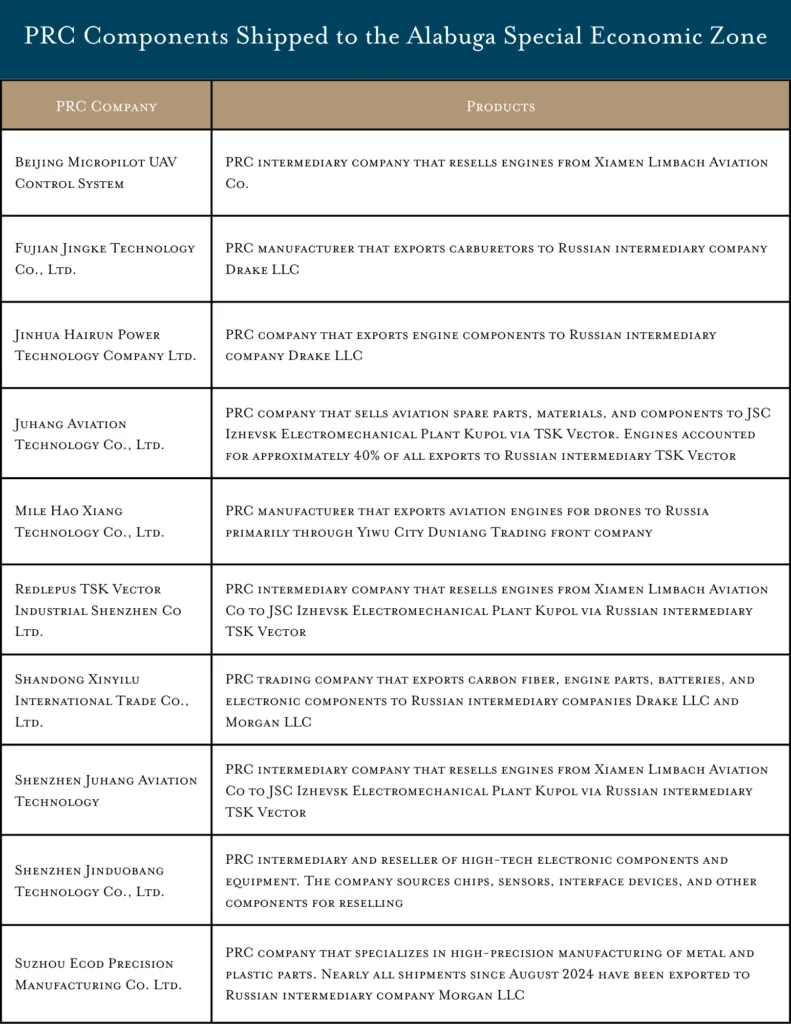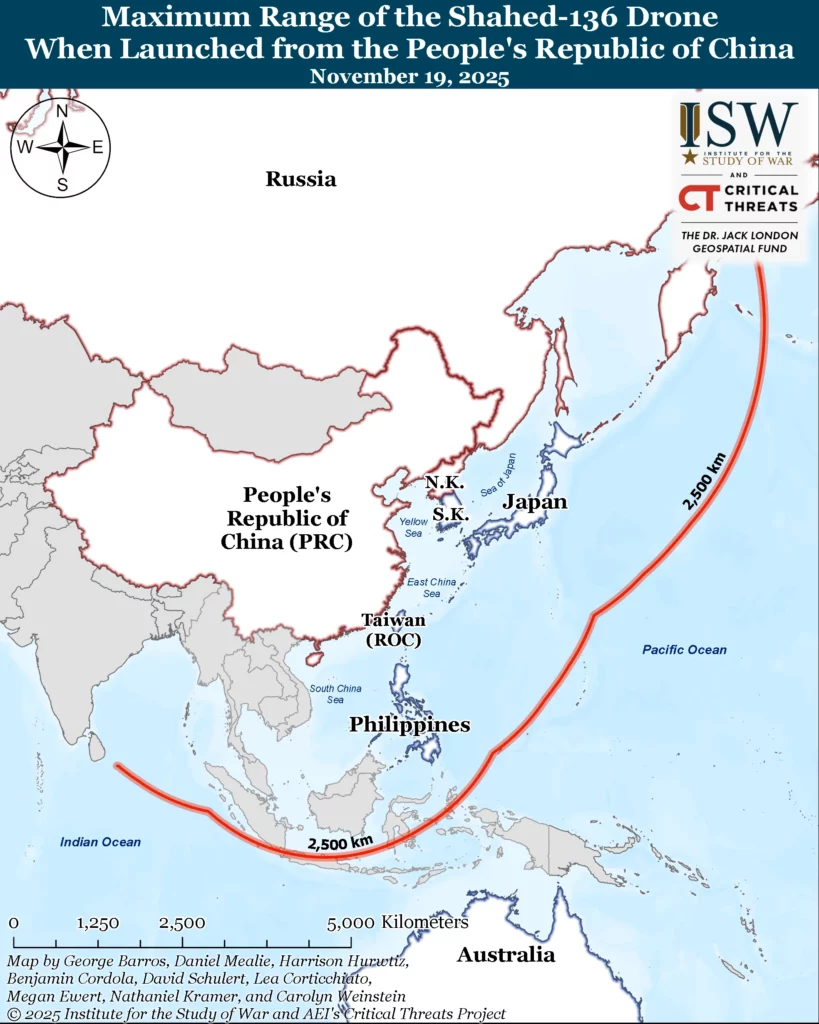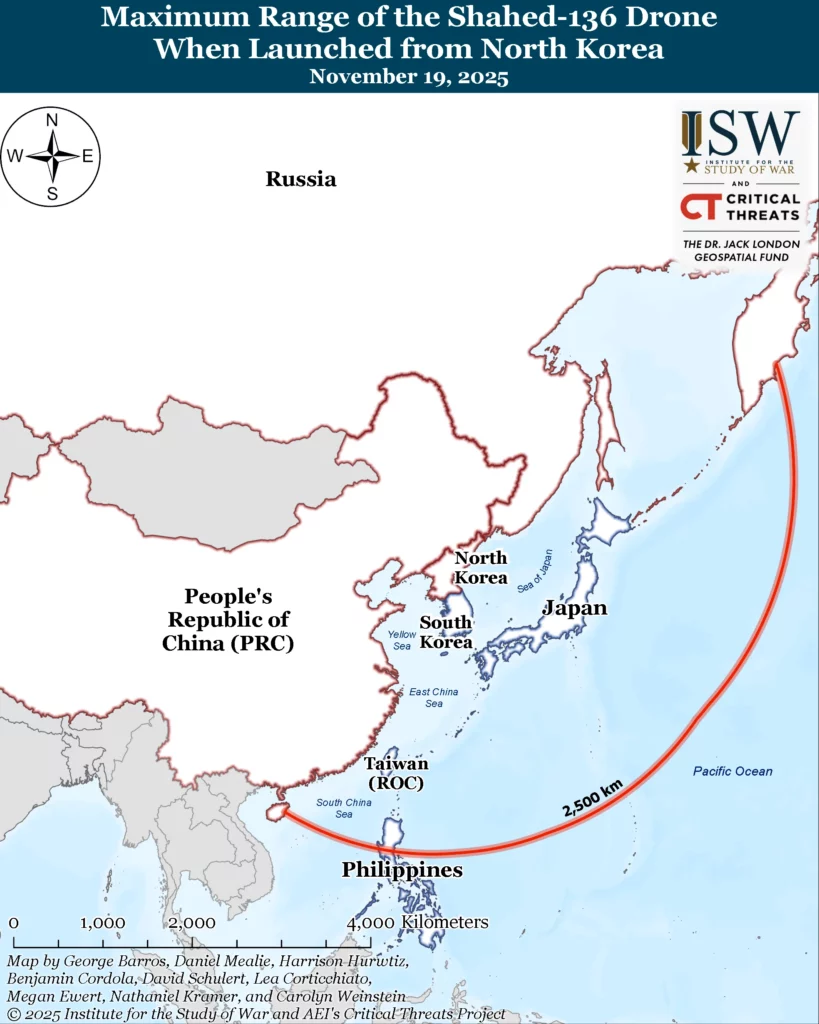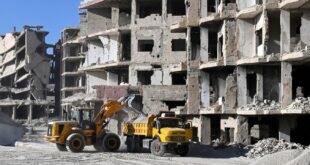The Alabuga Special Economic Zone (ASEZ) is a cornerstone of the Adversary Entente’s resistance against the US-led international coalition and is emblematic of the symbiotic relationship between its members. What started as a bilateral Russo-Iranian drone production effort in 2022 has expanded into a four-way center of technological and innovative exchange between Russia, Iran, the People’s Republic of China (PRC), and North Korea. The ASEZ produces Russian long-range drones based on the Iranian Shahed drone design that Tehran provided to Moscow in 2022.[1] The ASEZ currently produces roughly 5,000 Shahed-type drones per month, or 60,000 drones annually.[2] The PRC and Iran have contributed technical and materiel support to develop fleets of Iranian-designed Russian drones.[3] Reports have suggested that North Korea may send workers to the ASEZ, which could expand drone production exponentially.[4] Adversary Entente support for the ASEZ has allowed Russia to fully indigenize the drone assembly process, relying heavily on PRC-origin parts, and the PRC, Iran, and North Korea will, in turn, be able to apply lessons learned from ASEZ production processes and the performance of Russian drones on the battlefield in Ukraine in future conflicts in their respective theaters.
Russia, the PRC, Iran, and North Korea are aligned within the Adversary Entente around the common objective of challenging American global primacy and the US-led world order, usually through non-binding understandings that neither require nor exclude the possibility of materiel support in the event of armed hostilities. Each member is pursuing this objective within its respective theater, aided to some degree by other members of the Adversary Entente. Cooperation between members of the Entente in one theater undoubtedly has implications for other theaters, as the ASEZ exemplifies.
The ASEZ has transformed from a Russian effort to attract foreign investment into the epicenter of Adversary Entente learning. The Republic of Tatarstan’s Ministry of Land and Property Relations established the ASEZ in 2006 in Alabuga, Tatarstan, as an industrial park designed to attract foreign investors with customs and logistical incentives.[5] The ASEZ operates several different subordinate entities that provide logistical and manpower resources to support its operations.[6] Shortly following Russia’s full-scale invasion of Ukraine in February 2022, Russia and Iran negotiated a foreign military sales agreement wherein Iran would provide Russia with drones and various short-range munitions in exchange for Russian combat aircraft and other unspecified weapons transfers.[7] Russia and Iran signed a subsequent agreement in February 2023 to establish a drone manufacturing facility at the ASEZ.[8] This agreement marked a watershed moment in the bilateral Russo-Iranian relationship and set the groundwork for future Adversary Entente coordination at the ASEZ.
Iran provided Russia with drone components and manufacturing expertise, which has served as the foundation of Russia’s current drone program at the ASEZ. ISW-CTP observed a significant increase in the number of bilateral meetings between senior Russian and Iranian defense officials following Russia’s 2022 full-scale invasion, as both Tehran and Moscow appeared to be negotiating the terms of their cooperation during the war.[9] These meetings culminated in several defense agreements in rapid succession, establishing conditions for Iran to export drone capabilities and expertise to Russia. Iran began providing Shahed-131 and Shahed-136 one-way attack drones to Russia in August 2022, and Russia began fielding the drones in Ukraine by September 2022.[10] The Shahed-131 and Shahed-136 are Iran’s primary medium and long-range one-way attack drones and comprise the core of Iran’s drone fleet.[11] Russian officials negotiated a deal in late 2022 for a subsidiary of Iran’s Ministry of Defense and Armed Forces Logistics, Sahara Thunder, to deliver and produce “thousands of drones per year” at the ASEZ.[12] An Iranian delegation visited a potential manufacturing site at the ASEZ in January 2023 and, shortly thereafter, Russian drone manufacturer Albatross LLC announced plans to establish a drone production facility at ASEZ.[13] The Institute for Science and International Security assessed that drone production at ASEZ may have begun by July or August 2023 using Iranian-provided components.[14] CNN, citing unspecified analysts and intelligence officials, reported that Russia had indigenized approximately 90 percent of its Shahed-136 drone assembly by August 2025.[15]
Iran’s provision of drone components and the base production model to Russia have been critical in enabling Russia to initiate drone production, implement modifications, and indigenize drone assembly.[16] Russia has renamed drone models from their original Iranian “Shahed” to Russian “Geran”, possibly in an attempt to obfuscate the clear Iranian origin, but has retained Iran’s original base drone designs.[17] Iran provided Russia with 600 disassembled Shahed-136 drones, training, technology, and some components, including the engine and warhead for approximately 1,350 additional drones as part of a $1.75 billion contract signed in 2023.[18] Under the 2023 agreement, Iran also provided Russia with components for Shahed warheads to assemble in Russia and training on how to produce the high explosive warhead through 2024. Ukraine’s military Trophy and Advanced Weapons and Military Equipment Center reported that Ukrainian forces had discovered more lethal warheads on the Russian Gerans compared to the initial Iranian Shahed designs by fall 2023.[19]

The PRC has become a key enabler of Russia’s defense industrial base since 2022 through its provision of key military goods. Russia is expected to spend approximately $192 billion on defense and security in 2025, but international sanctions and pre-existing industrial and resource deficiencies have restricted Russia’s ability to modernize and scale production.[20] The Center for Strategic and International Studies (CSIS) assessed that Russia had some domestic capacity to produce various electronic items for military goods but preferred to source them from external suppliers.[21] The PRC has far surpassed all other suppliers in every export category since March 2023 and hosts nearly all the top microelectronic exporters to Russia.[22] This jump in trade coincided with the beginning of drone production at the ASEZ, though that is not the sole driver of this relationship. The PRC has the world’s largest manufacturing base and is capable of producing and exporting goods at a higher rate and lower cost than Iran.[23] Iran also shifted its focus to preserving its weapons stockpiles following the outbreak of the October 7 War, making it a less reliable source of supply, and Russia has shifted its focus to the PRC in parallel. The PRC’s strategic alignment with Russia against the US-led international coalition has also made it an ideal supplier for Russia as the two cooperate to shield transactions from scrutiny and international sanctions.
PRC-origin components for Shahed-variant and other drone models are critical for Russia’s drone production at the ASEZ. Ukraine’s Foreign Intelligence Service reported in May 2025 that the PRC supplies Russia with approximately 80 percent of the critical electronic components that are used to make all Russian drones, including those produced at the ASEZ.[24] Ukrainian open-source intelligence company Frontelligence Insight found that Russia’s Shahed/Geran production is almost entirely dependent on the PRC.[25] Frontintelligence Insight viewed customs manifests that showed that the PRC provides 41 different components to the ASEZ for its long-range drone strikes. These parts include engines, electronic and mechanical components, batteries, antennas, radios, carbon fiber, carburetors, and telecommunications components.
The PRC and Russia have also developed key manufacturing and logistical infrastructure to scale drone production at the ASEZ. Russia imported production line equipment to the ASEZ from the PRC between 2024 and 2025 to manufacture drone hulls and navigation systems.[26] The PRC and Russia also established the Deng Xiaoping Logistics Complex at the ASEZ in September 2024 to facilitate shipments of PRC-sourced components for Russian drone production.[27] The logistics center includes six railway tracks and a processing center capable of facilitating 2.4 million tons of cargo annually.[28]
Frontelligence Insight identified several PRC companies as key suppliers of drone components to the ASEZ, including:

North Korea is reportedly “considering” sending workers to the ASEZ, which could increase Russia’s drone production by at least 33 percent. Japanese news outlet NHK reported on June 19, 2025, citing unspecified Western and Russian diplomatic sources, that North Korea is “considering” sending 25,000 workers to the ASEZ.[29] Ukraine’s Main Military Intelligence Directorate (GUR) later reported on November 14 that Russia plans for roughly 12,000 North Korean workers to start producing Shahed-type drones at the ASEZ by the end of 2025. It remains unclear if these 12,000 workers are part of, or in addition to, the originally reported of 25,000 workers.[30] ISW cannot independently confirm these reports, but commercially available satellite imagery captured on November 3, 2025, showed the construction of additional housing at the ASEZ, which could be used to house future North Korean workers. Alabuga documents leaked in 2023 showing plans for 2024 and 2025 estimated that one eight-hour shift at the ASEZ required 882 people to produce 10 drones a shift.[31] The planning documents stated that drone production took place in three eight-hour shifts, 246 days out of the year, placing annual drone production at 7,380 drones per year.[32] This estimate assumes employees work 40-hour workweeks and does not account for the overtime many foreign workers have reported being forced to work.[33] These estimates do not take into account technological advances in manufacturing, such as production lines, that Russia has implemented since 2023. Longer working hours and technological advances in drone manufacturing would increase this estimated rate of production. Ukrainian defense intelligence assessed in August 2025 that the ASEZ was able to produce over 5,500 drones per month.[34] It is unclear how Ukrainian intelligence assessed ASEZ’s rate of drone production, given that the ASEZ produced approximately 6,000 drones annually in 2024, but this assessment does align with concerted Russian efforts to scale-up drone production capabilities over the past year.[35] The Institute for Science and International Security calculated based on the leaked projections that 9,073 workers would be required to produce 10,000 drones annually. Based on Ukrainian intelligence estimates, the addition of 25,000 North Korean workers could increase drone production by 22,682 drones annually, or about 33 percent. It is unclear whether all North Korean workers would support drone production or other labor at the ASEZ.

The relatively low cost of drone production at the ASEZ would enable Russia to allocate resources to support other critical areas of its defense industrial base. Russia has struggled to produce modern technologically advanced systems and has largely relied on Soviet-era stockpiles.[36] Russia has also pivoted to lower cost systems in an attempt to recreate the frontline effects of higher-cost systems—for example, using cheap quadcopter-type drones to recreate some of the effects of traditional artillery systems on the battlefield, as Ukraine has done.[37] To compound this issue, Russia’s spending on defense and security is expected to contract slightly from over $163 billion in 2025 to $156 billion in 2026 to address economic strains and high inflation caused by an aggressive wartime economy, further limiting Russia’s defense industrial base.[38]
Shahed/Geran drone production at the ASEZ provides a cost-effective alternative to more advanced munitions. CNN, citing a Ukrainian intelligence source, reported that the cost per drone for Russia dropped from approximately $200,000 when originally purchased from Iran in 2022 to $70,000 when produced at the ASEZ.[39] Russia can thus reportedly produce approximately 14 Shahed/Geran model drones per Iskander-K cruise missile and 28 Shahed/Geran model drones per Iskander-M ballistic missile.[40] Russia uses swarms of Shahed-type drones to overwhelm Ukrainian air defenses and create openings for larger and more advanced precision-guided munitions to reach their target.[41] This tactic allows Russia to expend fewer expensive munitions to bypass Ukrainian air defense systems and preserve its stockpile of more expensive cruise and ballistic missiles for critical targets.
The ASEZ is also indicative of the way Russia relies on foreign partners to offset economic constraints caused by its invasion of Ukraine. The ASEZ also employs youth and other vulnerable demographics, including trafficked foreigners, as a source of low-cost labor outside of Russia’s strained labor pool to maximize the production of drones.[42] Russia has an extremely low unemployment rate of 2.5 percent as of 2024, with most of the population supporting the wartime economy or deployed to fight in Ukraine.[43] Russia is facing a severe labor shortage due in part to the over 1 million battlefield casualties and mass emigration out of Russia.[44] This depletion is compounded by stagnant birth rates.[45] Russian Labor Minister Anton Kotyakov reported in July 2025 that Russia is expected to be at least 2.4 workers short of its required labor force in 2030.[46] Russia is likely to increase its reliance on foreign workers to fill its domestic shortages. The reports of tens of thousands of North Korean workers planned for the ASEZ are consistent with Russia’s use of foreign labor to offset its domestic shortages.
Members of the Adversary Entente are reaping technical and doctrinal benefits from their cooperation at the ASEZ that they have begun to apply to their respective theaters. Cooperation between the PRC, North Korea, and Iran at the ASEZ has led to a proliferation of expertise in drone production. Russia’s drone warfare in Ukraine has additionally served as a case study for these members to use for their own research and development.
The PRC and Russia have expanded upon their transactional relationship at the ASEZ to share technical knowledge for research and development, which the PRC could apply to its own drone program for future aggression against Taiwan. Reuters reported in April 2025 that the People’s Liberation Army (PLA) sent officers to Ukraine “to draw tactical lessons from the war.”[47] The PRC and Russia have also signed multiple agreements in recent months to cooperate in developing drone technology.[48] Russia has reportedly sent Russian drone specialists to PRC factories, and has reportedly already established a drone factory within the PRC.[49] The PRC has supported Russia’s efforts to improve upon the Iranian base drone model to achieve more effective results on the battlefield in Ukraine.[50] The PRC has become Russia’s main supplier for fiber-optic cables, which have helped overcome Ukrainian electronic warfare counter-drone measures.[51] PRC military analysts have identified electronic warfare measures as a key issue that the PRC must also overcome in its drone program.[52]

North Korea and Russia are cooperating to transfer Shahed/Geran drone technology to North Korea. Ukrainian military intelligence reported in June 2025 that Russia and North Korea signed an agreement to produce Shahed/Geran drone models in North Korea.[53] This cooperation would complement North Korea’s potential decision to send workers to the ASEZ to participate in drone production, as these workers would obtain the necessary expertise on drone production to then apply to North Korea’s domestic production program. North Korea’s possession of Shahed-type drones would put Seoul and the entire Korean Peninsula comfortably within range for Pyongyang. It would also allow North Korea to threaten Japan and the Philippines. North Korean troops have also received direct drone and counter-drone training and experience while deployed alongside Russian troops in Kursk Oblast since Fall 2024.[54] North Korean troops could apply lessons from combat to support North Korea’s research and development process to adapt technology and tactics for the operational environment on the Korean Peninsula.

Iran has reportedly adapted its Shahed drone technology based on battlefield performance, which will pose additional challenges for US allies seeking to develop more effective counter-drone measures against the Iranian-led Axis of Resistance. Iran and its allies, particularly the Houthis, launched countless drone attacks against the United States, its allies, and international shipping between October 2023 and October 2025.[55] Axis drone attacks commonly attempted to fly under air defense radars to avoid detection before striking their intended target.[56] US forces stationed in Erbil, Iraq in 2023 reported that forces were largely unprepared to defend against Iranian-backed drone attacks.[57] Troops fortified bunkers, erected T-walls, and installed nets on top of buildings similar to Ukrainian net defenses to in an attempt to adapt counter-drone capabilities to Iranian-backed Iraqi militia’s aggressive drone attack campaign.[58] Iranian and Iranian-backed drone attacks across the region frequently suffered technical difficulties, however, and often fell short of their target or were intercepted. Russian drone advancements could address some of these technological shortcomings. “Ukrainian drone hunters” collected debris from a Russian drone attack in June 2025 and identified new Iranian-made technology.[59] The drone possessed “advanced” cameras, an AI-powered computing platform, a radio link for remote piloting, and anti-jamming technology.[60] AP cited an electronics expert who suggested that the anti-jamming technology found in the drone was produced within the past year.[61] Navigational technology found in the drone would improve the system’s accuracy and allow the user to maneuver more effectively, unlike previous models. Russia has commonly utilized PRC-origin components to adapt drones to Ukrainian electronic warfare capabilities, and the presence of Iranian-made capabilities suggests that Iran may be attempting to field test the technology. ISW has not yet observed Iran or members of the Axis of Resistance field drones with these capabilities in the Middle East, but maintains the assessment that cooperation at the ASEZ has been fundamental to providing Iran and its Axis of Resistance with a platform from which to experiment with modern war capabilities.
 Eurasia Press & News
Eurasia Press & News



